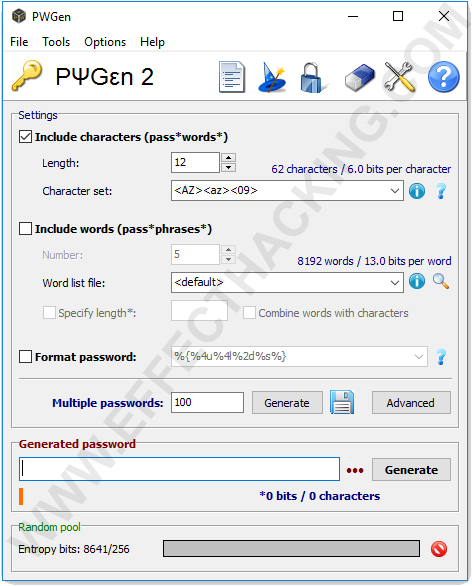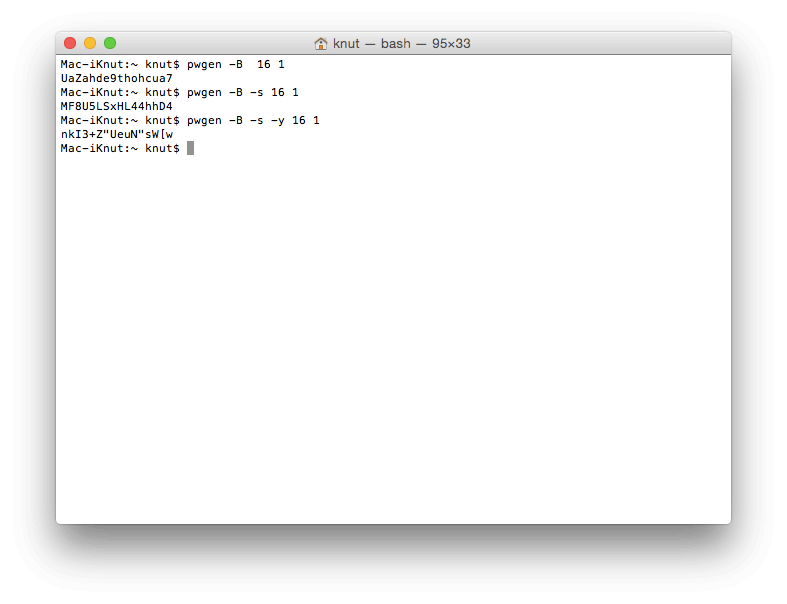

In situations like this, to emulate a different browser, pass the -U option. Sometimes when downloading a file, the remote server may be set to block the Wget User-Agent. To watch the status of the download, use the tailĬommand: tail -f wget-log Changing the Wget User-Agent #
Pwgen syntax iso#
In the following example, we are downloading the OpenSuse iso file in the background: wget -b īy default, the output is redirected to wget-log file in the current directory.
Pwgen syntax download#
To download in the background, use the -b option. If the remote server does not support resuming downloads, wget will start the download from the beginning and overwrite the existing file. In the following example, we are resuming the download of the Ubuntu 18.04 iso file: wget -c This is useful if your connection drops during a download of a large file, and instead of starting the download from scratch, you can continue the previous one. You can resume a download using the -c option. This option is useful when you don’t want wget to consume all the available bandwidth. The following command will download the Go binary and limit the download speed to 1MB:

Append k for kilobytes, m for megabytes, and g for gigabytes. By default, the speed is measured in bytes/second. To limit the download speed, use the -limit-rate option. The command above tells wget to save the CentOS 7 iso file to the /mnt/iso directory. To save the file to a specific location, use the -P option: wget -P /mnt/iso Downloading a File to a Specific Directory #īy default, wget will save the downloaded file in the current working directory.
Pwgen syntax zip file#
Zip file from GitHub as latest-hugo.zip instead of its original name. The command above will save the latest hugo To save the downloaded file under a different name, pass the -O option followed by the chosen name: wget -O latest-hugo.zip

Saving the Downloaded File Under Different Name #

If the file already exists, wget will add. To turn off the output, use the -q option. Once the download is complete, you can find the downloaded file in your current working directory The wget utility expressions take the following form:Īs you can see from the image above, wget starts by resolving the domain’s IP address, then connects to the remote server and starts the transfer.ĭuring the download, wget shows the progress bar alongside the file name, file size, download speed, and the estimated time to complete the download.
Pwgen syntax how to#
Installing Wget on Ubuntu and Debian # sudo apt install wget Installing Wget on CentOS and Fedora # sudo yum install wget Wget Command Syntax #īefore going into how to use the wget command, let’s start by reviewing the basic syntax. If wget is not installed, you can easily install it using the package manager of your distro. Otherwise, it will print wget command not found. If you have wget installed, the system will print wget: missing URL. To check whether the Wget package is installed on your system, open up your console, type wget, and press enter. The wget package is pre-installed on most Linux distributions today. This article shows how to use the wget command through practical examples and detailed explanations of the most common options. Wget provides a number of options allowing you to download multiple files, resume downloads, limit the bandwidth, recursive downloads, download in the background, mirror a website, and much more. With Wget, you can download files using HTTP, HTTPS, and FTP protocols. GNU Wget is a command-line utility for downloading files from the web.


 0 kommentar(er)
0 kommentar(er)
